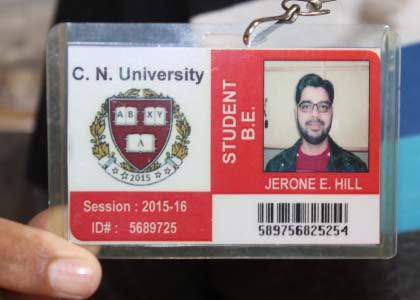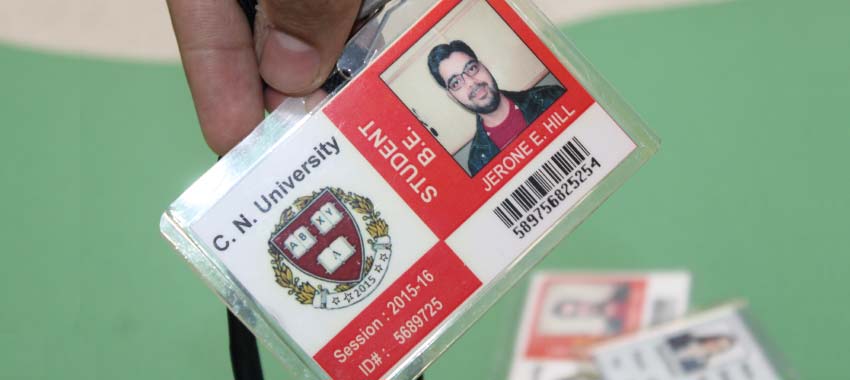Use Pre-made Templates or Designs
you can use pre-made templates or designs for your student ID badge designs, and there are several benefits to doing so. Let's explore them in detail:

-
Time-saving:
Pre-made templates provide a starting point for your ID badge design, saving you time and effort in creating the design from scratch. Templates often include pre-designed layouts, graphics, and placeholders for the required information, such as the student's name, photo, and ID number. By using a template, you can quickly customize it to suit your institution's needs and preferences, reducing the overall design time.
-
Professional appearance:
Many pre-made ID badge templates are designed by professional graphic designers or specialized companies. These templates are often created with aesthetic considerations in mind, incorporating visually appealing elements, balanced layouts, and appropriate typography. By using such templates, you can ensure that your ID badges have a polished and professional appearance without the need for extensive design skills.
-
Consistency:
Pre-made templates offer a level of consistency in design across all ID badges within the institution. When everyone uses the same template, it ensures a unified look and feel, which promotes a sense of belonging and reinforces the institution's branding. Consistency also facilitates recognition and identification by staff, faculty, and security personnel.
-
Customizability:
While pre-made templates provide a starting point, they are usually customizable to suit your specific requirements. You can modify various elements within the template, such as colors, fonts, graphics, and placement of information, to align with your institution's branding guidelines. This allows you to add unique touches and personalize the design while still benefiting from the template's structure and design expertise.
-
Cost-effective:
In many cases, pre-made ID badge templates are available at a lower cost compared to hiring a professional designer or design agency to create custom designs. This makes them a cost-effective option, especially for institutions with limited budgets or smaller-scale ID badge projects. Templates offer a balance between affordability and quality, allowing you to achieve visually appealing designs without significant financial investment.
-
Accessibility:
Pre-made ID badge templates are readily available online, either for purchase or as free resources. This accessibility means you can browse through a wide range of designs and choose the one that best suits your needs. It eliminates the need to start from scratch or rely on limited in-house design resources, making the design process more accessible to individuals with varying levels of design expertise.
-
Updates and scalability:
Using pre-made templates allows for easier updates and scalability. If there are changes to the badge design or information requirements in the future, you can simply modify the template accordingly, ensuring consistency across all badges. Additionally, templates can be easily replicated and adjusted for different departments or campuses within the institution, providing a scalable solution that maintains consistency across the organization.
Trends in Student ID Badge Designs
Student ID badge designs have evolved over the years to reflect current design trends and cater to the preferences of students. Here are some of the notable trends in student ID badge designs:
-
Minimalist Designs:
Minimalism continues to be a popular design trend across various mediums, including ID badges. Clean, simple, and streamlined designs with minimal embellishments or distractions are favored. These designs often feature a focus on typography, using clean and legible fonts combined with a limited color palette. Minimalist designs provide a sleek and modern aesthetic.
-
Customization and
Personalization:
Many institutions now offer options for students to personalize their ID badges. Customization can include elements like choosing a background color, adding a personal photo, or selecting additional design elements. This trend emphasizes individuality and allows students to express their preferences and personality through their ID badges.
-
Incorporation of School
Branding:
Schools are increasingly incorporating their branding elements into ID badge designs. This includes the use of school logos, colors, and typography to create a cohesive visual identity across all school-related materials. By aligning the ID badge design with the overall brand, it helps to foster a sense of belonging and identity within the student community.
-
QR Codes and Digital
Integration:
With the rise of digital technology, QR codes are being integrated into ID badge designs. These codes can be scanned using a smartphone or other devices, allowing for quick access to additional information or services. For example, scanning a QR code on a student ID badge could provide access to the student's digital portfolio or educational resources.
-
Security Features:
In an effort to enhance security, ID badges are incorporating more advanced security features. This includes the use of holographic elements, embedded microchips, or RFID (Radio Frequency Identification) technology. These features help ensure the authenticity and integrity of the ID badge, making it more difficult to counterfeit.
-
Lanyard and Holder
Designs:
The design of lanyards and ID badge holders has also seen changes. Lanyards now come in a variety of styles, colors, and materials to match the overall design aesthetic. Badge holders have become more functional and stylish, with options for customization, additional pockets for cards or keys, and even retractable badge reels.
-
Sustainability and
Eco-Friendly Design:
In recent years, there has been an increasing focus on sustainability and eco-friendly design practices. This trend is also reflected in student ID badge designs. Schools are opting for materials that are environmentally friendly, such as recycled or biodegradable materials. Additionally, some institutions are adopting digital ID badges or smart cards to reduce waste associated with physical badges.
-
Integration of
Technology:
Technological advancements are being integrated into ID badge designs. For instance, some ID badges now incorporate NFC (Near Field Communication) technology, allowing for contactless transactions or access control. This technology enables students to use their ID badges for various purposes, such as making payments or accessing restricted areas.
-
Geometric Shapes and
Patterns:
Geometric shapes and patterns are increasingly used in ID badge designs to create visually appealing and modern aesthetics. These designs often feature overlapping shapes, grid patterns, or geometric illustrations. The use of geometric elements adds visual interest and can help create a unique and dynamic design.
-
Collaborative Design:
Some institutions involve students in the design process of their ID badges. This trend promotes a sense of ownership and engagement among students by allowing them to contribute ideas and feedback. Student involvement can result in designs that better represent their needs and preferences.
It's important to note that design trends are subjective and can vary based on the institution, region, and individual preferences. Keeping up with current design trends and incorporating elements that resonate with the student community can help create ID badges that are visually appealing and relevant to the current design landscape.
Ensure that Student ID Badge Designs are of High Quality

To ensure that your student ID badge designs are of high quality, follow these detailed steps:-
-
Understand the Requirements:
Start by familiarizing yourself with the specific requirements and guidelines provided by your educational institution. This may include the dimensions, logo placement, color schemes, typography, and any other branding elements that should be incorporated.
-
Research and Gather Inspiration:
Look for inspiration from other well-designed student ID badges, professional ID badges, or any relevant designs. Explore different design styles, color combinations, and typography choices. This research phase will help you generate ideas and gain a better understanding of what constitutes a visually appealing ID badge.
-
Create a Clear and Consistent Design:
Your ID badge should have a clean and easy-to-read design. Avoid clutter and ensure that the information is presented in a clear and organized manner. Use a hierarchy of font sizes to highlight important details such as the student's name, photo, and identification number.
-
Typography and Font Selection:
Choose fonts that are legible and appropriate for the purpose of the ID badge. Select a font for the main text (e.g., student name, school name) that is clear and easy to read. For additional details, such as contact information or a slogan, consider using a complementary font that adds visual interest while maintaining legibility.
-
Color Palette:
Select a color palette that aligns with your institution's branding guidelines, if applicable. Use colors that are visually appealing and provide sufficient contrast to ensure readability. Consider using a limited color scheme to maintain a cohesive and professional look.
-
Logo Placement:
If your institution has a logo, ensure that it is incorporated into the design in a prominent and visually appealing manner. Pay attention to its size, placement, and how it interacts with other design elements. The logo should be recognizable and enhance the overall aesthetics of the ID badge.
-
Photo Quality:
If the ID badge includes a student photo, ensure that the photo is of high quality and has good resolution. Avoid using low-resolution or pixelated images, as they can negatively impact the overall impression of the badge.
-
Test Printing:
Before finalizing the design, print a test copy of the ID badge to evaluate its quality in physical form. Check for any issues such as color accuracy, image clarity, or font legibility. Make necessary adjustments and iterate on the design if needed.
-
Seek Feedback:
Share your design with others, such as colleagues, teachers, or students, and gather their feedback. Consider their suggestions and make improvements accordingly. Feedback from different perspectives can help you identify any potential issues or areas for enhancement.
-
Pay Attention to Details:
Double-check all the details, including names, identification numbers, and other information, to ensure accuracy. Typos or incorrect information can undermine the quality and professionalism of the ID badge.
-
Professional Printing:
Once you are satisfied with the design, consult a professional printing service to ensure high-quality printing. Provide them with the finalized design files in the appropriate format (e.g., PDF, PNG, or vector file) and discuss any specific printing requirements or finishes you may have, such as lamination or holographic elements.
Remember, quality is subjective, and it's important to adhere to the guidelines and requirements set by your educational institution. By following these steps and paying attention to the details, you can create student ID badge designs of high quality that are visually appealing, functional, and representative of your institution's brand.
Posted By: 👤 Tech Solution
Last Updated On: